Unit - 3
Multiple access techniques in wireless communication
Q1) Explain FDMA?
A1)
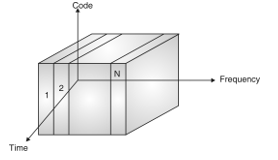
Fig. 1 FDMA
Uplink | 890.2 MHz, 915 MHz |
Downlink | 935.2 MHz to 960 MHz |
Uplink (UL) and downlink (DL) can be described with the help of one relation among them as follows:
fd = fu + 45 MHz
If UL frequency is :
fu = 890 MHz + n∙ 0. 2 MHz
Then
fd = 935 MHz + n ∙ 0. 2 MHz
Q2) Explain TDMA?
A2)
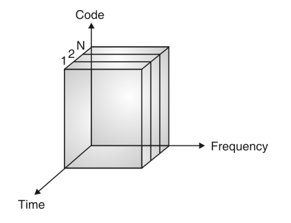
Fig. 2 TDMA
Q3) Explain SDMA?
A3)
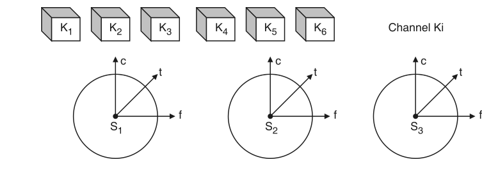
Fig. 3 SDMA
A cable consists of several fiber which are used as bi-directional pairs.\
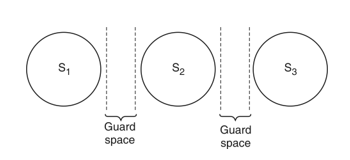
Fig. 4 Guard Spaces
Interference’s risk is reduced by guard space between frequency space.
Q4) Explain CDMA?
A4)
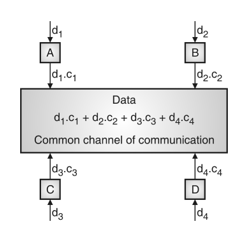
Fig. 5: Communication of station with code
Q5) Compare all the multiple access techniques?
A5)
Approach | SDMA | TDMA | FDMA | CDMA |
Idea | Segment space into cells/sectors | Segment sending time into disjoint time-slots, demand driven or fixed patters | Segment the frequency band into disjoint sub-bands | Spread the spectrum using orthogonal codes
|
Terminals | Only one terminal can be active in one cell/one sector | All terminals are active for short periods of time on the same frequency | Every terminal has its own frequency. uninterrupted | All terminals can be active at the same place at the same moment uninterrupted. |
Signal separation | Cell structure, directed antennas | Synchronization in the time domain | Filtering in the frequency domain | Code plus special receivers |
Advantages | Very simple, increases capacity per km2 | Established, fully digital, flexible | Simple, established robust | Flexible, less frequency planning needed, soft handover |
Disadvantages | Inflexible, antennas typically fixed | Guard space needed (multipath propagation), synchronization difficult | Inflexible, frequencies are a scarce resource | Complex receivers, needs more complicated power control for senders |
Comment | Only in combination with TDMA, FDMA or CDMA useful | Standard in fixed networks, together with FDMA/SDMA used in many mobile networks | Typically combined with TDMA (frequency hopping patterns) and SDMA (frequency reuse) | Still faces some problems, higher complexity, lowered expectations: will be integrated with TDMA/FDMA |
Q6) Derive Spectral efficiency of different wireless access technologies?
A6) As we know radio frequency resource is very vital in wireless communication system. Hence RF frequencies should be maximally utilized. Following are the methods used to improve the spectrum utilization.
• Cell planning
• Frequency reuse
• channel assignment
• multiple access techniques
In general, spectral efficiency depends upon following parameters.
• Channel spacing in KHz
• frequency reuse factor • cell area in Km2
• Modulation techniques
• Multiple Access techniques of types
Spectral efficiency = 
Q7) Derive Spectral efficiency in FDMA system?
A7) η = Ndata/cluster / (BWt * N * Acell)
= N * Ndata/cell / (BWt * N * Acell) channels/MHz/Km2
Where, Acell is the area of each cell
Ndata/cell = [ {(BWt - 2*Bg)/Bch} - Ncntl]/N
BWt is total bandwidth,
Bch is channel bandwidth,
Bg is guard band bandwidth,
N is number of cells per cluster
Q8) Derive Spectral efficiency in TDMA system
A8) Spectral efficiency of Wide band TDMA and narrow band TDMA is expressed as follows:
ηWTDMA = {(Tf - Tp - Tt)/Tf} * (Ni/Ns)
Where,
Tp = preamble period,
Tt= trailer time period,
Tf= frame duration
Ns= number of symbols in a time slot, Ni = number of information bits
ηNTDMA = {(Tf - Tp - Tt)/Tf} * (Ni/Ns) * {(Nsub * Bch)/BWt}
Nsub = Number of sub bands
Nslot = Number of slots
Q9) Spectral efficiency for DS-CDMA system.
A9) Spectral efficiency of DS-CDMA system is expressed as follows:
η = Us * Rb/W ... bits/S/Hz
Where Rb is information bit rate
W = system bandwidth for one direction
Us =system utilization